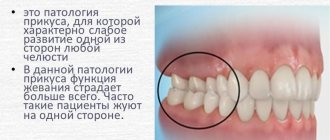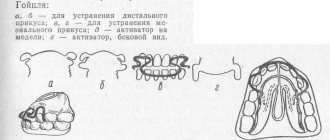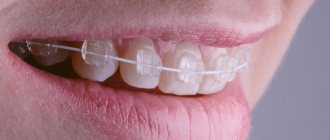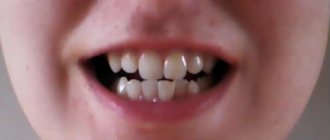Braces allow you to correct your bite not only for children, but also for adults. It is much easier for the younger generation to straighten their teeth and form a beautiful smile, since their jaws are still growing and their teeth move quite quickly. And children and teenagers have fewer problems getting used to braces.
Adults have to spend more time and make significant efforts to form an attractive set of teeth and finally begin to smile openly and without embarrassment. Therefore, very often, during a consultation with a dentist, patients who need a quick and inexpensive bite correction ask the question: “Is it possible to straighten teeth using metal-ceramics?”
Is it possible to correct a bite without orthodontic systems?
Orthodontic treatment is aimed at correcting serious deficiencies: straightening protruding or misaligned teeth, reducing interdental spaces, and ultimately correcting all types of malocclusions. To do this, braces change the position of teeth in three planes at once, simultaneously affecting bone tissue and dental ligaments.
Patients who do not want to spend a lot of time wearing braces can indeed undergo dental prosthetics in Moscow . At the same time, the attractiveness of the dentition will be restored, since the teeth will look even and beautiful, and the gaps between them will be hidden by dentures. But it will not be possible to eliminate all the consequences of an incorrect bite, since a denture does not allow changing the incorrect location of the tooth roots, and therefore does not eliminate the root cause of the anomaly.
In this case, it is more correct to talk not about bite correction with dentures, but about the prompt restoration of the natural dentition and the correction of its individual defects. There is a special name for the corresponding technologies in dentistry - microprosthetics.
Indications and restrictions
Installation of crowns to correct the bite is indicated in the following cases:
- surface defects that are not practical to eliminate with filling;
- reduced or enlarged teeth;
- the interdental space is greatly increased;
- teeth are crooked or rotated;
- the upper part of the teeth is significantly destroyed;
- discrepancy of teeth.
Not all bite defects can be corrected by installing a permanent crown. The limitation will be a violation of not only the shape, but also the root of the tooth, and the small thickness of the tooth. In this case, there is a risk of thermal burn of the pulp and a small supply of dentin, which may not be enough for grinding.
Veneers and inlays - modern types of dental prosthetics
A partial alternative to orthodontic structures can be elements made from high-tech ceramics, which allow:
- restore the integrity and functionality of the tooth;
- change its shape or “turn” around its axis;
- eliminate chips on its surface;
- visually reduce the large gap between the front teeth;
- restore the dentition when one or two teeth are lost (adhesive prosthetics).
The cost of microprosthetics is quite affordable, considering that along with the rapid restoration of the aesthetics of the dentition, the chewing ability of the teeth is also restored. Modern technologies make it possible to produce ceramic inlays and veneers that are indistinguishable in color and shape from the patient’s healthy teeth. Microprostheses are made by a dental technician using an individual impression, so they fit tightly to the surface of the teeth and have a long service life. It is also important that when microprosthetics is applied to a tooth, its healthy neighbors are not subjected to treatment and do not experience additional stress.
Quick appointment Free consultation
Material used for work
Prostheses are made from stainless steel, dental ceramics, plastic and a combination of the above materials.
- Steel
The most common material is stainless steel due to its strength, manufacturability and low price. For prosthetics, a socket is used, which is stamped at a factory or in a clinical laboratory. The top of the workpiece is coated with ceramics, plastic, or titanium nitride is sprayed for a “gold-like” coloring.
- Metal alloys
Alloys of gold, silver, cobalt, and titanium are used to make prostheses. Such crowns do not cause allergies, are resistant to oral fluid, and have a long service life. Disadvantage: low aesthetics.
- Metal ceramics
Their base is metal, resistant to cracking. Ceramic mass is applied on top, which can be given an aesthetic appearance.
- Ceramics
This material is closest in color to tooth enamel. Dental ceramics are highly durable and can withstand heavy chewing loads.
- Metal-plastic
Plastic crowns are fragile and are used temporarily until permanent structures are made. Metal-plastic dentures have a base made of metal and an applied plastic coating, which looks aesthetically pleasing. With careful use, these crowns will last for several years.
Stages of crown installation
You will have to visit the dentist's office several times when getting dentures. It is necessary to examine the teeth, take x-rays of problematic units, sharpen them, and select materials. An impression is taken from the tooth, from which a crown will be made in the laboratory. It is bleached, sanded, and only then installed.
Care Tips
Crowns do not require special care. It is necessary to brush your teeth 2 times a day. It is better to use flosses, rinses, brushes. It is not recommended to chew hard foods. It is advisable to quit smoking.
Alternative methods
| Click to sign up for a FREE consultation |
The bite can be corrected in other ways, for example, by doing exercises, installing mouth guards, fixed orthodontic devices, or undergoing surgery.
During gymnastics, dysfunction of the muscles of the face and jaw is put in order. This is what often leads to malocclusion.
Orthodontic structures (braces) use metal arches to act on abnormally located teeth. Disadvantage: long wearing time, high price.
Mouth guards are removable polymer pads that cannot be worn all the time. Operations to correct the bite are carried out in difficult cases when other methods do not help.
A good bite ensures proper chewing of food, good speech and a beautiful smile. Due to improperly positioned teeth, complications can develop, including severe migraines and ear diseases.
Ceramic inlay - microinsert that replaces a filling
As you know, before filling a tooth affected by caries, the doctor first excises its non-viable tissue. Therefore, in case of secondary caries, when the filling has to be re-placed, due to the significant size of the cavity, the tooth is already practically destroyed. The patient is recommended to undergo depulpation and cover it with a crown.
Recurrence of caries occurs due to the lack of proper sealing between the walls of the tooth and the composite filling, which decreases in volume during polymerization. The ceramic inlay is free of this drawback; it is manufactured individually with high precision and therefore fits tightly to the tooth. The ceramic material of the inlay does not shrink and does not change color or shape during use.
Microprosthetics with inlays is performed on teeth whose defects make up up to 30% of the volume of their coronal part, and allows you to create exact copies of teeth with the correct shape of the chewing surface.
Treatment
On the first visit, a minimally invasive preparation of 9 teeth of the upper jaw was carried out, which took no more than 60 minutes, that is, about 7 minutes per tooth, which, in our opinion, is a lot, since the preparation was minimally invasive (Fig. 4). The bite is fixed in the usual occlusion with the first layer of silicone impression material. In the frontal region, the impression mass is removed before it hardens, which allows for visual control of the position of the lower jaw in relation to the upper jaw and subsequent optical registration of the bite (Fig. 4).
Rice. 4.
A light-curing composite was used to directly restore the lost tissue of the two central maxillary teeth, after which the patient was asked to close his mouth. The lower jaw teeth were inserted into the grooves of the impression material until the composite contacted the lower teeth, and the new position of the jaws was registered virtually. Thus, the position of the lower jaw in relation to the upper jaw remained stable, without deviation from the usual occlusion, and the height increased by the size of the temporary restorations (Fig. 5).
Rice. 5.
Virtual modeling of teeth is a simple procedure, since everything happens automatically and only in some cases does a doctor’s intervention be required. In this case, modeling of 9 teeth took no more than an hour, milling of 9 restorations took just over two hours, glaze firing took two times for 15 minutes, fixation, occlusal correction and polishing of the occlusal surface took just over two hours: total time was six seconds. half an hour, if you add one hour for preparation. But the patient’s appointment time is reduced due to the fact that all stages, except preparation, occur not sequentially, but in parallel; The fact that the dentist has two well-trained assistants further reduces the appointment time.
For example, the 26th tooth is virtually modeled, a ceramic block of the required size and color is inserted into the milling machine, and the milling process begins. And at this time, teeth 25 and 24 are modeled (Fig. 6), after milling the 26th tooth, its fitting is carried out, the approximal and distal contacts are checked, and the restoration of the 25th tooth is milled in parallel.
Rice. 6.
When 3-4 restorations are ready, with verified approximal contacts, glaze is applied, and these restorations are sent for glaze firing. At the same time, the stages of virtual modeling, milling, fitting and fixation of the remaining restorations continue (Fig. 7).
Rice. 7.
After the glaze firing, the restorations are cemented with DUO CEMENT VITA. After fixing all restorations, the teeth are ground according to occlusion and the areas to be corrected are polished.
Thus, in this clinical case, the total time of the first appointment was 4 hours 45 minutes (Fig. 8). To control the parallelism of the line of occlusion and the line of the pupils, the “smile design” option was used (Fig. 9, 10).
Rice. 8.
Rice. 9.
Rice. 10.
VITABLOCS TriLuxe forte 2M2 was chosen for the restoration. These blocks consist of four layers that differ in color intensity. In this clinical case, this made it possible to create natural color shades, as in the structure of a natural tooth, due to a subtle color transition from the enamel to the cervical layer with a more emphasized color in the lower part of the dentin and neck (Fig. 11, 12).
Rice. eleven.
Rice. 12.
At the second visit, it was planned to complete the prosthetics, but when the appointment time exceeded 5 hours, it was decided to postpone the restoration of the two remaining teeth, 32 and 33, to the next appointment. The preparation was also minimally invasive (Fig. 13-15). On the third visit, the work was completed (Fig. 16, 17).
Rice. 13.
Rice. 14.
Rice. 15.
Rice. 16.
Rice. 17.
Conclusion
Rapid patient recovery is not the primary criterion for the CEREC technique. The precision quality of the fit of the restorations, minimally invasiveness and information content still remain in the foreground: the dentist constantly sees a virtual model of the tooth being restored with high magnification and can promptly prevent his mistakes, because the patient is sitting in a chair. Dentistry today is aggressive, often the patient is offered to remove all teeth or completely dissect the remaining ones. In my opinion, dentistry more often harms than helps, the patient loses money, but does not gain health. The CEREC technique changes the main thing: the patient still loses money, but gains health for many years.
Veneers - surgical correction of tooth defects
When it is necessary in the shortest possible time to correct the position of a deployed, protruded or creeping onto an adjacent tooth, to eliminate the gap between teeth or to disguise extensive fillings, wedge-shaped defects and restorations, microprosthetics with veneers . A miniature, thin ceramic plate is also made from an impression and applied to the front surface of the tooth using a special adhesive composition. The surface of the veneer is indistinguishable from tooth enamel in color and other characteristics.
The possibility of dental treatment and prosthetics under general anesthesia allows you to restore the integrity of teeth with inlays and veneers with minimal discomfort for the patient.
Basis of construction
Determining the height of the bite is based on assessing the distance between the jaws when fully closed, which makes it possible to determine the correct development and location of the elements of the dentition. The presence of defects leads to a displacement of the main anatomical components of the jaw region - the lips recede, the facial folds increase, the chin protrudes, and the height of the lower part of the face decreases. Increasing the height of the bite restores aesthetics and facilitates further therapeutic measures.
How to quickly and easily carry out treatment before implantation
Those who have not previously thought about treatment with an orthodontist are not motivated to wear braces, and this is understandable. But now, thanks to aligners, it is possible to undergo treatment in a short time. In addition, such an orthodontic system is invisible to others. Aligners are superior to braces in most important parameters and are best suited for preparation for implantation, since treatment with them is quick.
Preparation for implantation can take from several months to a year, depending on the initial situation. But such comprehensive treatment will bring benefits in the future, since with a correct bite it is easier to maintain healthy teeth.
It is better to correct the bite as early as possible. But if this does not work out, then you can contact an orthodontist at any age, even at 45–50 years old and later (nowadays older patients are not uncommon).
Treatment of tooth canals before prosthetics
The healing of the implants was successful, so immediately after removing the braces, it was possible to begin dental prosthetics. Before dental prosthetics with crowns, the dental canals were re-treated with a microscope and the teeth were strengthened with pin inlays, where required. It is absolutely not necessary to depulpate teeth (treat canals) in all teeth on which crowns will be installed. Experienced Dial-Dent dentists install crowns on living teeth, using special tooth preparation technologies.
Mesial bite in a child
The sooner a malocclusion is corrected, the fewer consequences it will have. Untreated mesial bite in children is a common cause of health problems. It makes it difficult for a child to adapt to the society of his peers and causes the development of psychological complexes. Fortunately, the problem can be solved. In children, mesial occlusion can be treated much easier and faster than in adults.
- Conservative treatment methods are more suitable for young children.
- For older children, if necessary, it is necessary to perform surgical intervention in combination with hardware correction methods.
Let's take a more specific look.
In children aged 2.5-5 years, if there are prerequisites leading to mesial occlusion, the following therapeutic and preventive measures are taken: gymnastics for the facial muscles, monitoring the correct posture during sleep, massage of the upper jaw area, and the use of vestibular shields.
When a child turns 9 years old, he is prescribed a course of wearing a chin sling with a rubber rod. Additionally, various intraoral structures are used (type 3 Frenkel apparatus, Telebaev apparatus, Basharova apparatus, Bruckle apparatus, expansion plates, etc.)
From the age of 10, it is possible to use orthodontic systems (braces or mouth guards).
The main goal of treating mesial malocclusion in childhood is to correct the development of the lower jaw, which will help reduce its growth and displacement.
How long does tooth crown lengthening take?
Surgical lengthening of teeth is performed in just a day, regardless of the amount of work. Each tooth usually requires about ten minutes.
After a couple of weeks, or even earlier, the temporary dentures are fixed, and the correct gingival contour is formed around them.
After 3-5 months, permanent structures are installed. In general, orthodontic treatment, coupled with the retention period, takes 8-12 months.
Veneering and installation of crowns without surgery require only a few days.
Prices for bite correction
Orthodontic correction using a brace system.
Indirect fixation of one jaw. 5,000 rub.
Orthodontic correction using a brace system. Inspection and activation of the bracket system.
3,000 rub.
Orthodontic correction using a brace system. Re-fixation of the 1st bracket.
1,500 rub.
Orthodontic correction using a brace system. Fixation of the 1st bracket.
2,000 rub.
Orthodontic correction using braces on two jaws, 1st degree of complexity
103,000 rub.
Orthodontic correction using braces on two jaws, 1st degree of complexity, initial stage
50,000 rub.
Orthodontic correction using braces on two jaws, 1st degree of complexity, final stage
15,000 rub.
Orthodontic correction using braces on two jaws, 1st degree of complexity, scheduled visits
35,000 rub.
Orthodontic correction using braces on two jaws, 2nd degree of complexity
118,000 rub.
Orthodontic correction using braces on two jaws, 2nd degree of complexity, initial stage
50,000 rub.
Orthodontic correction using braces on two jaws, 2nd degree of complexity, final stage
15,000 rub.
Orthodontic correction using braces on two jaws, 2nd degree of complexity, scheduled visits
51,000 rub.
Orthodontic correction using braces on two jaws, 3rd degree of complexity
133,000 rub.
Orthodontic correction using braces on two jaws, 3rd degree of complexity, initial stage
50,000 rub.
Orthodontic correction using braces on two jaws, 3rd degree of complexity, final stage
15,000 rub.
Orthodontic correction using braces on two jaws, 3rd degree of complexity, scheduled visits
67,000 rub.
Orthodontic correction using braces on two jaws, 4th degree of complexity
147,000 rub.
Orthodontic correction using braces on two jaws, 4th degree of complexity, initial stage
50,000 rub.
Orthodontic correction using braces on two jaws, 4th degree of complexity, final stage
15,000 rub.
Orthodontic correction using braces on two jaws, 4th degree of complexity, scheduled visits
83,000 rub.
Orthodontic correction using braces on one jaw, 1st degree of complexity
48,000 rub.
Orthodontic correction using braces on one jaw, 1st degree of complexity, initial stage
25,000 rub.
Orthodontic correction using braces on one jaw, 1st degree of complexity, final stage
7,500 rub.
Orthodontic correction using braces on one jaw, 1st degree of complexity, scheduled visits
17,500 rub.
Orthodontic correction using braces on one jaw, 2nd degree of complexity
59,000 rub.
Orthodontic correction using braces on one jaw, 2nd degree of complexity, initial stage
25,000 rub.
Orthodontic correction using braces on one jaw, 2nd degree of complexity, final stage
7,500 rub.
Orthodontic correction using braces on one jaw, 2nd degree of complexity, scheduled visits
RUB 25,500
Orthodontic correction using braces on one jaw, 3rd degree of complexity
64,000 rub.
Orthodontic correction using braces on one jaw, 3rd degree of complexity, initial stage
25,000 rub.
Orthodontic correction using braces on one jaw, 3rd degree of complexity, final stage
7,500 rub.
Orthodontic correction using braces on one jaw, 3rd degree of complexity, scheduled visits
RUB 30,500
Orthodontic correction using braces on one jaw, 4th degree of complexity
74,000 rub.
Orthodontic correction using braces on one jaw, 4th degree of complexity, initial stage
25,000 rub.
Orthodontic correction using braces on one jaw, 4th degree of complexity, final stage
7,500 rub.
Orthodontic correction using braces on one jaw, 4th degree of complexity, scheduled visits
RUB 41,500
Orthodontic correction using braces. Treatment with partial braces.
20,000 rub.
Dental implantation under sedation
Dental implantation and bone grafting in areas where the bone width was not enough (bone grafting) were carried out under sedation, that is, the patient was in a medical sleep and did not feel anything. Sedation helps to avoid anxiety and anxiety during surgical interventions, and to do a large amount of work in one operation. In this case, 8 dental implants were installed under sedation and bone grafting was performed.
Astra Tech dental implants were installed, which are distinguished by the highest reliability, biocompatibility and quality of all components. The clinic has been working with Astra Tech dental implants for more than 15 years, completely trusting them.
The cost of installing one Astra Tech implant at Dial-Dent, including the implant itself, is 38,900 rubles.
The cost of sedation is 12,500 rubles for the first hour, and 6,000 rubles every next 30 minutes.
A surgical template was used to install dental implants. The doctor calculated in advance the direction, inclination, and depth of installation of the implants. The technician made a special pad - a surgical template, which helped install the implants in exactly the intended places. With a surgical template, surgery time is reduced and the quality of implant placement is improved.
Professional dental hygiene to prepare for complex treatment
Before tooth extraction or dental treatment begins, all Family Dental patients undergo professional oral hygiene. The Air Flow method completely removes dental plaque, and ultrasound removes tartar. On clean teeth, areas affected by caries, enamel cracks and other problems are clearly visible. Removing tartar restores normal blood circulation to the gums. Reducing the microbial load after professional oral hygiene improves tissue restoration after tooth extraction or other surgical procedures.
The cost of comprehensive professional oral hygiene is 6,900 rubles.
Dial-Dent specialists who took part in this work:
- Orthopedic dentist S.V. Zukor – diagnostics, treatment planning, dental prosthetics with ceramics, including prosthetics on implants.
- Implant surgeon V.P. Alaverdov – tooth extraction, dental implantation under sedation, bone grafting.
- Anesthesiologist D.V. Sidorov – consultation before sedation, monitoring the patient’s condition throughout the entire operation.
- Orthodontist O.A. Baranova – consultation on bite correction.
- Neuromuscular dentist A.V. Galeev – neuromuscular diagnostics and treatment.
- Dentist-endodontist Yu.A. Borisova – dental treatment with a microscope, re-treatment of dental canals, dental revision with a microscope.
- Dental hygienist E.P. Smirnova – comprehensive hygienic preparation before dental treatment, hygienic support, development of an individual oral care program.
- Dental assistants M. Erkimbekova, L. Kharlamova, A. Antoshkina.
See other examples of the work of Dial-Dent specialists here.
Make an appointment for a consultation on dental prosthetics by calling +7-499-110-18-04 or using the form on the website. You can ask questions about dental prosthetics to the chief doctor of the clinic, Sergei Vladimirovich Tsukor, at
Surgical tooth lengthening
In modern dental practice, tooth crown lengthening is performed using techniques such as:
- surgical,
- orthodontic,
- orthopedic,
- therapeutic.
The essence of the procedure is to increase the size of the area of the tooth protruding above the gum. Surgical restoration is used in cases of significant damage to the coronal part, and in addition, if it is necessary to change the contour and position of the gums in patients with a gummy smile.
Some people believe that the surgical method is just excision of part of the gum tissue, or gingivectomy. However, this technique is used only in situations where passive teething is impaired, apical displacement of the gum does not occur and excess gum forms on the tooth.
Thoughtless excision of the gingival margin and subsequent prosthetics of a given volume of the coronal part disrupts the “biological width” - the zone of attachment of the gum to the tooth. This, in turn, can cause severe periodontal inflammation and even tooth loss.
The classic method of surgical lengthening involves excision of the periodontal groove, which performs hygienic, protective and immunological functions. After this, it may not recover completely, a scar will form and the original function will be impaired. To minimize the risk of such an outcome, a technique was developed for surgical lengthening of the crown of the tooth without excision of the gum edge. Today this is the safest and most effective way to a beautiful smile.
What does a deep bite look like?
A deep bite is one of the most common types of improper closure of teeth, in which the upper teeth overlap the lower teeth by more than 1/3 of the crown.
This fairly common anomaly has several stages. The initial stage, when the lower teeth come into contact with the palatal tubercle of the upper ones, is called deep incisal overlapping. It is the least dangerous and does not affect the patient’s health until a certain time. The phrase “deep bite” refers to the second phase, in which there is practically no contact between the teeth of both jaws or it occurs only at the very base of the upper incisors. The very last stage is considered difficult to treat and very invasive, hence its name - deep traumatic bite. At this stage, the lower teeth are constantly in contact with the soft tissues of the upper jaw, causing inflammation.
Important!
If the anomaly is not eliminated in time, sooner or later it will move to the next stage and require more serious treatment of a deep bite.











